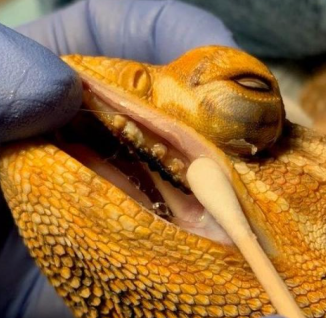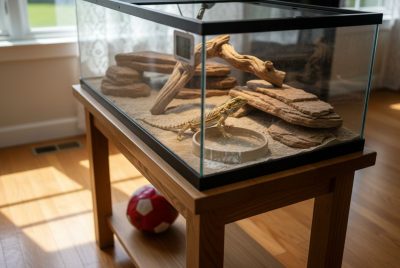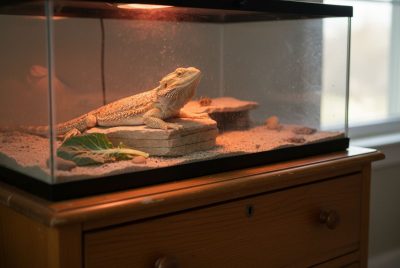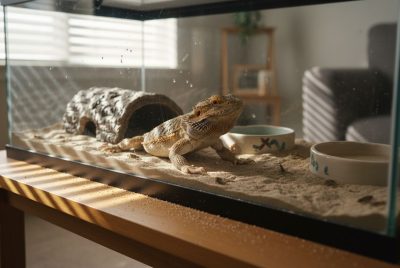Bearded Dragon Mouth Rot: A Practical Care Guide
When I first spotted a white patch and a bit of goo around my bearded dragon’s mouth, my heart dropped. I’d heard the term “bearded dragon mouth rot” thrown around in forums, but seeing something on my own dragon made it real — and scary. Over the years, I’ve learned that mouth rot (stomatitis) is one of those issues where early recognition and sensible action make a massive difference. In this guide, I’ll walk you through what bearded dragon mouth rot is, why it happens, how vets treat it, what you can safely do at home, and most importantly — how to prevent it. I’ll also share a couple of stories from my own dragons so you get practical, real-world perspective.
What Is Bearded Dragon Mouth Rot (Stomatitis)?
Medical Definition in Simple Terms
Mouth rot, medically called stomatitis, is an infection and inflammation of the mouth tissues — gums, tongue, inside of the cheeks. It can look like white or yellowish pus, swollen gums, ulcers, or necrotic (dead) tissue. Think of it like a dental infection on steroids: the tissue becomes painful, inflamed, and sometimes breaks down.
Why It Shows Up in Bearded Dragons
Reptiles don’t get mouth diseases for mystical reasons — it’s usually a combination of something that damages the mouth (a scrape, bite, or abrasive food) plus poor conditions or low immunity that let bacteria overgrow. Bacteria that normally live harmlessly in the mouth can turn opportunistic when the animal is stressed or injured.
Common Causes & Risk Factors
Poor Husbandry and Nutrition
In my experience, nearly every mouth rot case I’ve seen had poor husbandry as a contributing factor. Incorrect temperatures, missing UVB, or poor diet weaken a dragon’s immune system and slow healing. Nutritional imbalances — low calcium or vitamin D3 — make tissues more fragile.
Oral Trauma and Foreign Objects
Mouth injuries are a very common trigger. A sharp piece of substrate, an over-large feeder insect, or rough handling can nick the oral tissues. That tiny wound is all bacteria need to start trouble. I once found a tiny piece of gravel stuck near the gumline — nasty.
Weakened Immunity & Stress
Stressors like overcrowding, frequent handling while sick, or shipping can suppress the immune system. Sick or brumating dragons are also at higher risk because their bodies aren’t focused on fight-off infections.
Recognizing the Signs Early
Visual Symptoms (What to Look For)
| – White, yellow, or gray discharge in the mouth or at the lip line. |
| – Redness, swelling, or raw-looking tissue inside the mouth. |
| – Black necrotic patches (in serious cases). |
| – Bad smell from the mouth (a very common clue) |
Behavioral Clues: Appetite, Drooling, Attitude
Dragons with mouth rot often stop eating or prefer soft foods, may paw at their mouth, drool, or be lethargic. If your normally eager eater turns away from food, pay attention — it may be painful to eat.
When Signs Are Subtle
Sometimes a small white patch or slightly off-smell is the only clue. That’s why regular close-up checks are so useful — I check my beardies’ mouths during weekly handling sessions. A headlamp and a gentle retract of the lips go a long way.
How a Vet Diagnoses Mouth Rot
Physical Exam and Oral Swabs
A vet will examine the mouth and usually take a swab or small tissue sample to identify the bacteria or fungi involved. That’s crucial because treatment depends on the organism.
Possible Blood Work, Imaging, or Cultures
If the infection seems systemic or the animal is very sick, vets may recommend bloodwork, radiographs, or a culture with sensitivity testing to pick the right antibiotic. Don’t worry — it’s standard and important.
Veterinary Treatment Options
Systemic Antibiotics & Pain Management
Most cases need a vet-prescribed antibiotic. This is not something to self-prescribe: the choice of drug, dosage, and duration should come from the vet. Pain management (analgesics) and sometimes anti-inflammatories are also used so the dragon can eat and recover.
Debridement and Professional Cleaning
In moderate to severe cases, the vet may remove dead tissue (debridement) or clean the area under anesthesia. This can be the turning point — removing necrotic tissue helps healthy tissue heal.
Follow-up Care and Monitoring
Expect follow-up visits to ensure the infection is resolving. Vets often re-check cultures and may change meds if things aren’t improving. This is normal — take notes, and ask questions at each visit.
Safe At-Home Supportive Care
While a vet handles diagnostics and prescriptions, you can do several supportive things at home that truly help recovery. I used these methods with my dragons, and they made a noticeable difference.
Warm Soaks for Hydration
A warm (not hot) shallow soak helps hydrate and loosen debris. I soak my dragons for 10–15 minutes once or twice daily while they’re not eating well — it helps hydration and comfort. Always supervise soaks.
Gentle Saline Rinses — When and How
If the vet approves, rinsing the mouth with sterile saline (warm) can help remove pus and debris. Use a syringe without a needle, gently flush the mouth, and let the fluid flow out naturally — don’t force it down the throat. Saline is safe and won’t damage tissue like alcohol or strong disinfectants can. Always ask your vet before starting rinses.
Soft Feeding & Nutritional Support
Offer soft, easy-to-eat options: finely chopped vegetables, mashed or moistened greens, and softened pellets or pre-killed, chopped feeder insects. If your dragon won’t eat, vets sometimes recommend assisted feeding or syringes — only do that under instruction. Proper nutrition supports healing.
What NOT to Do at Home (Warnings)
Avoid DIY Antibiotics or Strong Disinfectants
Never give your dragon medication meant for humans or other animals without veterinary guidance. Don’t use hydrogen peroxide, alcohol, or harsh antiseptics in the mouth — they damage delicate tissues and slow healing.
Don’t Ignore the Problem
Mouth infections can progress from mild to life-threatening. If you notice discharge, lousy appetite, or foul odor — see a vet. Waiting only makes treatment more invasive and recovery longer.
Prevention: Husbandry & Daily Checks
Proper UVB, Temperature, and Diet
Good husbandry is your first line of defense. Consistent UVB, correct basking and ambient temperatures, balanced calcium and vitamin D3, and a varied diet keep the immune system strong. I never skip checking my UVB bulb schedule — it’s that important.
Clean Enclosures & Safe Substrates
Avoid loose substrates like sand for young dragons or those prone to impaction or mouth injuries. Keep enclosures clean and rinse water dishes daily. A clean tank reduces pathogen load.
Handling, Enrichment, and Reducing Stress
Stress weakens immunity. Provide hides, predictable handling, and a stable routine. Quarantine new dragons until you’re confident they’re healthy. I quarantine new additions for at least 30 days and inspect their mouths closely.
My Personal Experiences & Lessons Learned
Case: “Nibbles” — Early Detection Saved Us
Nibbles developed a tiny white spot at the corner of her mouth after chewing a large cricket. I noticed it during a routine check, rinsed with warm saline, and called my vet. The vet prescribed a course of antibiotics and recommended warm soaks. Within 10 days, she was back to normal. Early action was the key.
Case: “Ginger” — When a Vet Had to Debride
Another dragon, Ginger, had a deeper infection with a foul smell and poor appetite. The vet had to anaesthetize her, clean the mouth, and remove necrotic tissue. That intervention was uncomfortable but necessary — Ginger recovered fully with follow-up meds and better husbandry. It taught me never to downplay signs.
Recovery Timeline & What to Expect
Short-Term Signs of Improvement
Look for reduced swelling, less discharge, improved appetite, and brighter behavior. Often, owners see meaningful improvement within a week of starting vet care, but every case varies.
When to Expect Full Recovery
Mild cases may resolve in 2–4 weeks; moderate to severe infections can take longer — sometimes months with check-ups and supportive care. Always finish the full course of medication and keep follow-up appointments.
Conclusion
Mouth rot is scary, but it’s also manageable — especially when caught early. The single best things you can do are keep excellent husbandry, do regular oral checks, and get veterinary help as soon as you suspect a problem. Treat your dragon’s mouth issues like you’d treat a child’s tooth infection: prompt, careful, and professional. With the right care and a calm approach, most beardies bounce back stronger.
FAQs
- Can mouth rot go away on its own?
Sometimes mild irritations resolve, but true mouth rot is an infection and usually needs veterinary treatment. Don’t gamble — get the vet involved early.
2. Is mouth rot contagious to humans or other pets?
The bacteria involved are typically opportunistic and adapted to reptiles; transmission risk to humans is low but good hygiene is essential. Quarantine affected dragons from other reptiles until cleared.
3. Can I use saltwater, vinegar, or hydrogen peroxide to clean the mouth?
No — don’t use vinegar, hydrogen peroxide, or alcohol. They can damage tissues. Sterile saline (vet-approved) is the safe rinse. Always check with your vet first.
4. How often should I check my dragon’s mouth?
I check mine weekly during handling sessions and during feeding. Increase checks if the dragon is under stress, new to your home, or not eating.
5. Will poor temperature cause mouth rot by itself?
Poor temperature weakens the immune system and slows healing, making infections more likely. It’s usually a contributing factor rather than the sole cause.




